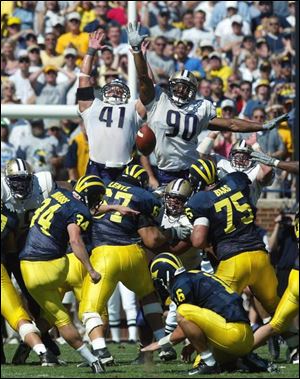
Kickers not considered real players until they win game
9/7/2002
Walk-on placekicker Phillip Brabbs (34) made this winning 44-yard field goal for Michigan, despite missing twice earlier.
Kickers, especially placekickers, are sometimes like kickstands. They can hold you up, but when you don't need them, you just kick them out of the way.
And when they let you down, you kick them harder.
While most of their teammates are getting a free education as scholarship athletes, placekickers often are kicked around like tenderfoots. They're asked to walk on at their own expense and take one for the team. One less scholarship that is.
Coaches have only 85 scholarships, and they often don't want to use one on a diminutive kicker who comes from what they might wrongly perceive as a sissy sport, that being soccer.
“With the 85 limit you don't want to be the first to pull the scholarship trigger until someone else does, then you get into what's market value,” Indiana coach Gerry DiNardo was saying this week. “You don't necessarily offer until you have to, whereas with an offensive or defensive lineman you know going in no one is going to get in that position without paying for it.”
Many high-profile Division I-A football teams, such as seventh-ranked Michigan, rely on walk-on placekickers to save the day for their more athletic teammates and, more importantly, their million-dollar programs.
Michigan trotted out walk-on Philip Brabbs to kick field goals of 36 and 42 yards against Washington last Saturday. Brabbs, a fourth-year junior who last kicked a field goal in a game in 1998, when he was a senior at Dow High School in Midland, Mich., missed them both.
With the game on the line and 1:29 remaining, the Wolverines turned to Troy Nienberg, a third-year sophomore, whose last field goal came in 1999, when he was a senior at Ottawa-Glandorf High School. He missed a 27-yarder.
OK, miracles do happen. How about one more chance for the Wolverines with four seconds left? Brabbs, the goat, got a chance to gloat. This time he drilled a 44-yarder and Michigan won 31-29.
You have to wonder why walk-ons are occasionally asked to be messiahs and walk on water.
Michigan has a scholarship kicker in sophomore Adam Finley, who was expected to contend for the placekicking and punting assignments this season.
“When we recruited Finley, we thought he could potentially do both,” Michigan coach Lloyd Carr said. “After our situation with Hayden Epstein we felt if it [competition] was close, we would rather have two people handle the kicking chores.”
Epstein, a heavily recruited placekicker, was the Wolverines' placekicker and punter last year, but Michigan's punting ranked sixth in the Big Ten.
Brabbs and Nienberg, an all-league soccer player in high school, showed enough promise as placekickers that Finley has been left to concentrate on punting, where he averaged 45 yards in five punts against the Huskies.
“We don't feel any added pressure. That's the nature of the position,” said Nienberg, a transfer from Dayton, where he also walked on, kicking one extra point for the Flyers. “We feel we're two very proficient kickers and we expect to do well. The difference between a great day and a bad day is one play, and that's rough.”
DiNardo says he approaches his kicking game like any other position, with kickers having a separate coach and being prone to making mistakes like every other player.
He alluded again to “market value” in explaining why walk-on kickers, especially placekickers, are in the limelight so much, even at the Division 1-A level.
“If there's a kicker in high school and another [college] is offering him a scholarship and you want to get in on it, you have to offer the same deal. If a kicker's out there and he's not offered [a scholarship], then we all compete for different reasons. We talk about our business school or whatever we're selling at that time.”
Wisconsin coach Barry Alvarez said he has two scholarship placekickers, but a walk-on placekicker outperformed them both during two-a-day practices.
“When you evaluate high school kickers you're evaluating someone kicking off a tee,” he said. “Many high school kickers have a tough transition kicking off the ground. We fell victim to maybe a little complacency when we probably went eight years with three consecutive kickers who were outstanding. We made some recruiting mistakes and had to depend on some walk-on kickers.”
Nienberg, who played soccer six years with the Toledo Celtics, was at Dayton for one semester before he transferred to Michigan, seeing an opportunity with the graduation of Epstein. He said he attempted five or six field goals at Ottawa-Glandorf his senior year, the majority of which were blocked.
Carr said that earlier in his coaching career “in many cases kickers were not an integral part of the team. They didn't have the same practice routine and the same demands. We try to do things that show they are a part of the team, and we look at the role they play in regard to your team's success. They're a vital part of the team.”
Some walk-on kickers who become successful are offered scholarships, even if it endangers the esteemed 85.